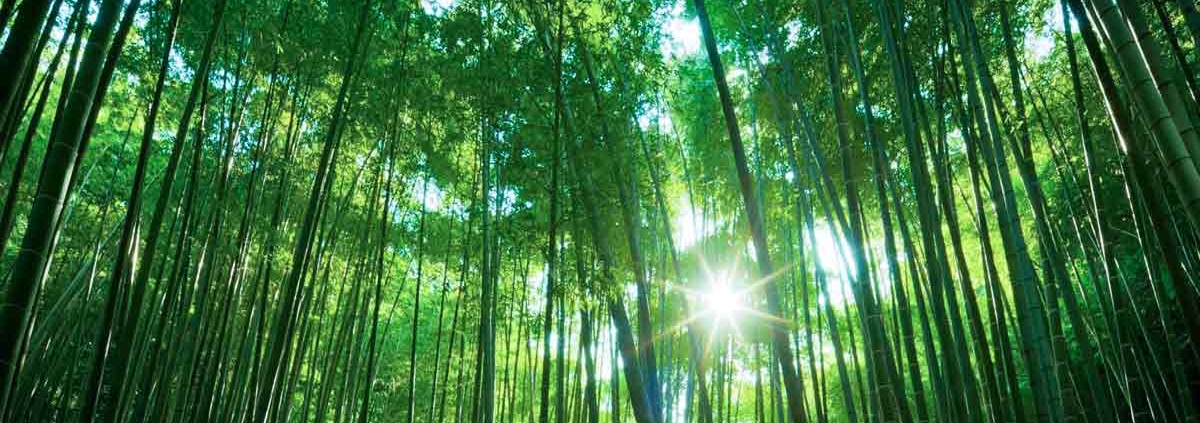What is bamboo toilet paper?
Bamboo toilet paper is a more sustainable alternative to regular wood pulp paper. Surprise, surprise, it’s made from bamboo. Bamboo, despite being a grass, has similar properties to hardwoods such as oak, maple or birch, which are commonly mixed with softwood trees such as pine to make regular toilet paper.
Bamboo is incredible stuff, it really is. Not only does it feed pandas, it can also be used to make roads, buildings, furniture, food, clothes, toothbrushes, bicycles and yes, toilet paper.
Where does bamboo toilet paper come from?
The type of bamboo used to make A Good Toilet Paper, Most Bamboo, is grown in Guizhou, China, where the factory is also located. The border mountains of Guizhou have been identified as one of the eight plant diversity hotspots in China. The main flora types include evergreen broad-leaved forest, coniferous and broad-leaved mixed forest, montane elfin forest and a lot of bamboo. This means that our bamboo is not being grown on deforested land as it has been grown there for thousands of years.
How is bamboo toilet paper made?
The process of making toilet paper from bamboo is fairly straightforward and clean. Raw Bamboo is first turned into pulp and then pressed into paper in giant-size rolls. These are later divided into small rolls for smaller creatures like us. No bleach needs to be used, and the wastewater is taken care of in a closed-loop system. Furthermore, the factory is powered by solar.
With A Good Toilet Paper, we also added two innovations:
- We exchanged the inner roll from wood pulp-paper to bamboo paper
- We removed all plastic from around each roll. Instead, we pack them individually with bamboo paper. 0% plastic, better designs.
What certificates exist?
The strongest guarantee that the bamboo is sourced sustainably is that it has been certified by the FSC (ours has). The FSC Bamboo mark not only ensures environmental sustainability, but it also promotes the core conventions of the International Labour Organization, meaning that vital workers’ rights are upheld.
Comparison bamboo toilet paper vs regular toilet paper
When comparing bamboo toilet paper vs regular wood-based toilet paper it is necessary to consider the growth and harvesting of the raw materials and also the production of the paper itself.
Growth and harvesting, bamboo vs wood
Technically a member of the grass family (we love grass), bamboo is in the Guinness world record book as the fastest growing plant on earth, growing at a rate of up to 1m per 24hours. It’s actually possible to watch it grow!
It takes around seven years to reach maturity and, being a grass, regrows as soon as it’s been cut. When harvested, a new shoot grows from its extensive root system, so bamboo does not need replanting or additional cultivation and can be harvested every year after reaching maturity. When compared with the woods commonly used to make regular toilet roles (oak, maple, birch, pine) they can take 20-100 take to mature and are then chopped down and the stumps burnt for fertiliser.
Bamboo also absorbs twice the amount of carbon as trees and produces 30% more oxygen. It’s hardy too, requiring no chemicals, pesticides or fertilisers. It has natural antibacterial properties and discarded leaves provide all the nutrients needed when they start to decompose.
The water efficiency is twice that of trees, so it grows densely and can produce 20 times more usable materials in a single harvest. Typically the yields of bamboo of up to 150 ton per acre greatly exceed the yield of 25 tons for most trees. Also, as there’s no-deforestation occurring, the extensive root system remains intact and prevents soil erosion, saving nutrients for the next crop. This makes it truly one of the most efficient and sustainable materials around.
Regular toilet paper production
As we’ve already mentioned the process of making toilet paper from bamboo is simple and clean. The process of making the regular wood-pulp paper is much messier. To make paper first of all trees are cut down, itself an environmentally costly process. Next, a lot of water is needed to clean and prepare the pulp. A variety of chemicals are also involved in the manufacturing process. For example, chlorine is used to bleach the pulp white and makes toilet paper feel softer but with the drawback that it also severely pollutes local water sources.
100% biodegradable and flushable
Bamboo toilet paper is 100% biodegradable and breaks down well when flushed down the toilet. Also, as it doesn’t contain and bleaches or dyes, it won’t pollute the environment and it is also safe for use in septic tanks and on boats and RVs.
Use
At this point, you may be thinking “Yes! Sounds great, but there’s an undeniably important factor of toilet paper to be considered”. We hear you and we can confirm that yes, it is just as soft. Also, bamboo is naturally antibacterial making is perfect for use




